 

|
 

|
| ICS - 100 - 90 - 80 - 70 - 60 - 50 - 40 - 30 - 20 - 10 |
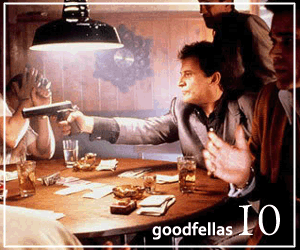 10. Goodfellas (Scorsese, 1990) 10. Goodfellas (Scorsese, 1990)
Tradition. Power. Family. Honor. Martin Scorsese’s canon is diverse, yet his films share many surprisingly similar thematic elements that tie them together in unexpected ways, and whether you’re comparing a masterpiece like Taxi Driver with The Departed or Alice Doesn’t Live Here Anymore to the visionary The Last Temptation of Christ, one can find these dominant themes throughout his entire body of work. Surprising parallels can even be found between the most unlikely of Scorsese-directed cinematic cousins: The Age of Innocence and Goodfellas. Each draws the viewer in, first visually, then emotionally, enticing them to enter into a world outside of their usual comfort zones, to suspend their disbelief for a couple of hours. Both are, in an almost magical way, fantasies, possessed of a bewitching sense of fatal romanticism. Like The Age of Innocence, Goodfellas is constantly moving — if you come across a static moment, you know there is some sort of storm on the horizon. Scorsese’s expertly cast American Dream gone haywire is flavored with the bittersweet seasoning of Shakespearean tragedy, offering a look at “respect” and its many meanings. There is an old-world version of this concept that the mob bosses are trying to protect, and there is the aggressively evolving new animal that is being spawned by a spoiled new-world culture. Henry Hill’s (Ray Liotta) crew, including his ne’er-do-well pals Jimmy Conway (Robert De Niro) and Tommy DeVito (Joe Pesci) and wife Karen (Lorraine Bracco), enjoy the quick fixes of hedonism and greed, whereas Paulie’s (Paul Sorvino) generation is more interested in maintaining appearances and preserving integrity. Scorsese’s triumph comes in not only joining the sophistication of the old world with the brash new (again, much like in The Age of Innocence), but also in reinventing a genre: giving “the mobster flick” a much-needed heart transplant. The shocking red blood and violence that the director uses to punctuate Goodfellas’ volatile reality is a fitting a metaphor here, much as the recurring motif of a blooming flower was intrinsic to The Age of Innocence’s explorations of rebirth, once again linking Scorsese’s two masterworks that have (coincidentally) both found their way into the top ten of the ICS’s Top 100 Films of the '90s. |
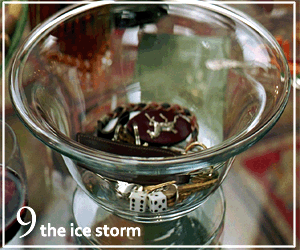 9. The Ice Storm (Lee, 1997)
9. The Ice Storm (Lee, 1997)
There is a comical yet entrancing shot of Ben Hood, imitating a golf game, wearing nothing but his underwear. Frederick Elmes stunningly frames him inside the reflective, modernist architecture of Janey Carver's home. Ben is in full view, uncertain and out of place. This shot, one of director Ang Lee's favourite images in the film, superbly encapsulates the vulnerable soul of America in 1973 and the subtle reverberations that have uncomfortably seeped into suburbia. In the world of New Canaan, Connecticut, two young families awkwardly negotiate with the debris from the sixties, second-wave feminism and the symbolic death of another father figure in the new decade. They are teetering, as it were, on the negative zone with all their flaws and peculiarities. The adults fumble with the freedom furnished by the sexual revolution, leaving it to the teenagers to grapple more honestly and openly with their fears. When Ben speaks to his son Paul who is at college, the spectre of Nixon shadows the conversation as he is simultaneously broadcast on mass communication and caricatured in a poster that undermines the master narrative of Watergate. This imagery, and Ben's golf game, are mere snippets of how the "parental units" exemplify a generation born of modernism slipping further into the grim reality of the "me" generation in all its post-modernist terror. This is a changing world cynical about the bureaucratic state that permeates their lives but with no real alternatives to guide them. When Mikey Carver, in all his hallucinatory, immortal joy, flirts with the ice with daring and a sense of the unknown, he connects the film, the audience and a generation with the negative zone: a zone that speaks of this transitory, unfamiliar world that you can either ride or it will swallow you whole. In this localised ice age of regeneration, Lee, with the benefit of new eyes, sees the young America that is mourning the loss of yet another world father figure with Nixon. As chronicled in the Fantastic Four, a 1960s creation, the family is your void that you emerge from and return to when you die, and it is almost healing when the film's flawed father figure carries the cold and still body of Mikey home. |
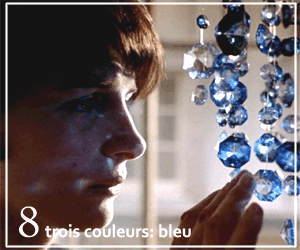 8. Trois couleurs: Bleu (Kieslowski, 1993)
8. Trois couleurs: Bleu (Kieslowski, 1993)
Certainly one of the most emotional and deeply moving films of the '90s, if not of all time, Krzysztof Kieslowski’s Three Colors: Blue grabs you in the first moments and refuses to let go. With a nearly speechless opening sequence, Kieslowski expertly guides us through a pastiche of images: speeding cars, candy wrappers, rolling beach balls, among others. By weaving these images together, Kieslowski immediately establishes tone, style, and story. Despite never seeing the car crash, the event that will loom over the lead character for the rest of the film, the emotion and sadness are still palpable. Part of what makes the sadness of the film so harrowing is due to one person: Juliette Binoche. Her performance as Julie remains one of her strongest, and in a career littered with masterful performances, that is no light praise. Her performance is stoic, subdued, nuanced, and even cold. In an age when overacting and loud outbursts are the standard for grief-stricken characters, how refreshing is it to see an actress go to the opposite end of the spectrum and achieve even more power and command in her performance. Despite being the heroine and the victim of a tragic accident, Julie is never portrayed by Kieslowski and Binoche as a saint. She is a real person suffering through real trauma with real actions powering her decisions and actions. Blue is also a technical masterpiece, featuring cinematography by Slawomir Idziak, editing by Jacques Witta, and original music by Zbigniew Preisner. Layering the film with all different shades of blue, Idziak captures some of the most exquisite images of both his and Kieslowski’s careers. The image of Julie swimming in a pool of pure blue, while all other colors have been crushed to black, is one of the most arresting ever put on film. Preisner’s score should also be considered an integral part of Blue’s success. Mirroring Julie’s transformation, the score sticks with a main theme that becomes more and more developed until the full power of the final piece is unleashed in the film’s final montage, Kieslowski’s most masterful sequence in his entire filmography. With the fully realized “Song for the Unification of Europe” playing, we revisit each of the film’s major characters as they silently come to terms with their place in life. Like each of the films in the Three Colors trilogy, Blue ends with a character staring into the camera, a tear rolling down one cheek. Again, this is a testament to Binoche’s performance. She does nothing, she does not move, as the tear comes sliding down her face. She merely stares into the camera, into your eyes, and commands your attention. So much is said in that final shot, yet so little is done. I can think of no image more fitting for a film whose entire purpose seems just that: to do so little, yet say so much. Kieslowski’s ability to marry the technical aspects and the performances into one unified creation gives this film an unprecedented power that few have managed to achieve. Blue is a quiet film, but it packs an emotional punch practically unparalleled. |
 7. Eyes Wide Shut (Kubrick, 1999) 7. Eyes Wide Shut (Kubrick, 1999)
Stanley Kubrick’s final opus, Eyes Wide Shut, is a perpetual mise-en-scene of high art recurring through a dream that is barely awake but not quite asleep. In this abstract simulation of an earlier fin de siècle, Alice and Bill Harford are transposed against the wealthy displays of decadence of Shostakovich, Renaissance bronzes, tapestries, oil portraits and Latin poetry. They are in this world, but not of it, and a late-night conversation about jealousy, lust and fidelity leads to a splitting of sorts that creates the film’s psychic apparatus. Alice’s dream of abandoning her life is both the viewer’s and her husband’s entry into the "id" of the film. Like l’enfant terrible Alex DeLarge, Alice taps into those dark, almost unreachable aspects of our personality that bubble on basic impulses. Each woman in Eyes Wide Shut is a reflection of Alice and her id that challenges and tempts Bill during his late-night odyssey. This man who doesn’t see the signs, who doesn’t look at his wife when he tells her she’s beautiful, is, dare I say it, a bobbing orange working like clockwork who finds himself startled by the demands of his ego, seeking answers to this agitation of raw desire. Kubrick uses the motifs of art, Christmas, red carpet and masks to connect us from the ball to the orgy and create an unceasing dreamlike sequence of the id. Tolstoy defined art as a human activity that can give others the feeling of what they have lived through and perhaps infect others with those feelings. Art can be about the sublime, the beautiful, an insight into the human condition. Kubrick, however, shows that this world is surrounded by art but disengaged from it. The art in wealthy Manhattan lacks the power to influence but makes the influential look powerful, suggesting that the beauty of a woman naked in a painting is pointedly positioned next to and yet a world away from a hooker lying motionless from an overdose. That art is just a display of the ego, commercialised, a commodity, like Christmas, that only serves as a mask to the primitive, almost nihilistic id-world of Ziegler. Kubrick, likewise, could be suggesting that his art may lack the power to change us, but by mirroring the human condition, as one scholar once said, he pushes us to be lucid about ourselves. Alex DeLarge showed us that, “When a man cannot choose, he ceases to be a man.” Bill Harford does make choices and starts to reconcile the potency of this dream with the sobriety of real life to re-emerge with eyes wide open. |
 6. My Own Private Idaho (Van Sant, 1991) 6. My Own Private Idaho (Van Sant, 1991)
A boy stands alone in the middle of a deserted road. An old pocket watch ticks away the time. The road is "smiling," but something is not right, we notice that soon. In a matter of seconds the world collapses around the boy and what is left is a distant memory mixed with the vivid, Van Gogh-inspired colors of a dream. The first few minutes of Gus Van Sant's My Own Private Idaho represent, maybe, one of the most striking and memorable sequences of the 1990s. The mood is set for a movie that, over a little more than 100 minutes, goes through sudden genre shifts, exploring Shakespearean farce and romance and musical and documentary and melodrama and road movie, but always maintains the dreamlike atmosphere that those first images suggest, always moves between consciousness and an alteration of reality as seen through the eyes of its lonely lead character. A lead, Mike (brought to life by River Phoenix in a state of rare cinematic grace), who's apparently clueless about whatever goes on around him, but is really the core of a film structured in concentric circles: Mike is alone, at the center, trying but afraid to break through, while he's progressively alienated from the world around, distant from his best friend because he's gay, distant from "normal" society because he's on the streets, ultimately distant from reality itself because of his illness that sends him into a confused comatose state every time things start getting too tough to handle. In making such a character protagonist of his story, Gus Van Sant probably gives one of the best (and most extreme) examples of '90s anxiety and solitude, of a whole generation that reaches for simple things (Mike only wanted a normal dog) and tries to keep up with a world changing fast all at the same time. And while Mike seems the designated victim of such a world, the sacrificial lamb who has to accept his fate so that other, stronger specimens can survive and prosper, Gus Van Sant does not give up hope, not for his youths anyway (Mike's mentor will succumb to his fate). There may be some possibility of final happiness for those who, like the character Van Sant so affectionately creates with Phoenix, possess that kind of sight an Italian painter once described as the way of poets, children and drunks: all those who can see a face saying "have a nice day" in the shape of a deserted road. |
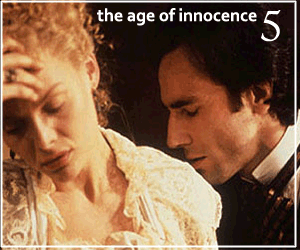 5. The Age of Innocence (Scorsese, 1993) 5. The Age of Innocence (Scorsese, 1993)
Scorsese’s adaptation of The Age of Innocence begins with the words of author Edith Wharton transposed over the delicate image of a blooming flower, a rose springing to life in slow motion. The flower can be seen as a representation of Wharton’s main female characters, Countess Ellen Olenska (Michelle Pfeiffer) and May Welland (Winona Ryder): delicate and remarkable like the fragrant petals, but with a surprisingly thorn-like sharpness added in by nature for protection from a rigid society that was particularly ruthless towards its women. The floral motif is carried throughout the film as Newland Archer (Daniel Day-Lewis) cultivates his life, his reputation, and his women, much in the way a gardener would meticulously tend to his land or a florist to a bouquet of freshly cut stems. In a grand homage to the history of film, particularly to the rich period films of Max Ophuls and Michael Powell and Emeric Pressburger, cinema enthusiast Scorsese stocks his frames with audacity — fur, silk charmeuse, and gleaming diamonds all harmonize in costumier Gabriela Pescucci’s concerto of textures, while Newland’s stroll through the Beauforts' town house recalls Scorsese’s own masterful tracking shot of Ray Liotta sneaking through the back door of the Copacabana in Goodfellas. For Newland, his fiancée May (whose very name indicates the promise of flowers) represents fragility in many ways, yet she is also a master strategist, a double agent in this world of manners and privilege. It is Newland's fantasy, the Countess, who truly symbolizes the paradox of the rose and thorn, the drama of the flower unfolding its petals. Her radiance and radical intelligence signal the end of Victorian repression, the freedom of sexual expression, and the eventual intellectual and emotional emancipation of women in the United States, while May represents tradition and formality, albeit with a prickly, modern twist. While Scorsese’s New York City in The Age of Innocence is just as ruthless as the city featured in the director’s Taxi Driver or Raging Bull, the real shock is that Scorsese’s best film comes not from the macho bluster of his (mostly male) explorations of Italian-American history (something he does brilliantly), but from a daringly feminist, female-centered perspective. Placing women at the forefront is both antithetical to his oeuvre and also firmly in keeping with his thematic explorations of danger in relation to beauty, much like the rose and thorn. |
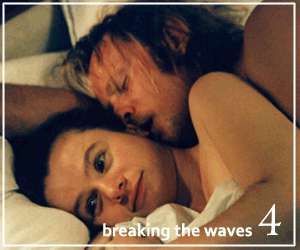 4. Breaking the Waves (von Trier, 1996) 4. Breaking the Waves (von Trier, 1996)
Lars von Trier's first film in his Golden Heart trilogy (Breaking the Waves, The Idiots and Dancer in the Dark) remains his crowning achievement and is indeed one of the best of the 1990s. Premiered during the 1996 Cannes Film Festival, this film made one of the biggest splashes in festival history. Von Trier broke waves, for the audience was not prepared to be blown away in epic proportion. The film stars Emily Watson and Stellan Skarsgård as two lovers put to the test when Skarsgård's character Jan is paralyzed after an accident in an oil rig. No longer able to perform sexual intercourse, a drugged Jan urges Watson's character Bess to go into sexual trysts with other men to keep Jan's passion alive, in spite of her deeply religious and conservative background. This leads to devastating consequences and ultimately a very tragic ending — an ending that ironically possesses an unexpectedly bright and optimistic undertone. Emily Watson delivers an endearing and iconic performance as Bess. In a way, this film reminds me of Bong Joon-Ho's Mother (2009) in that the strong female character goes to great lengths for her loved ones, even in self-deprecating fashion. Reminiscent of Ordet's contemplative style, the Dogme-filmed Breaking the Waves remains as the von Trier benchmark in the history of cinema. |
 3. Trois couleurs: Rouge (Kieslowski, 1994)
3. Trois couleurs: Rouge (Kieslowski, 1994)
I remember having read about Krzysztof Kieslowski’s Three Colors trilogy as far back as my sophomore year of high school. Knowing it was supposed to be pretty highly regarded and desperate to get my hands on all of those major films you always hear about, I decided to give it a try. Ignoring the order, I went straight to Red, the final film of the trilogy, as I had heard that this one was the masterpiece of the group. The experience of watching Red was easily one of the most powerful viewing experiences of my life. I’ve never before finished a film only to rewind it and watch it again. Kieslowski was giving me what other films at the time weren’t: an emotional resonance, a true connection with his story and characters. Whether it was the visual flair, the layered script, or the subdued performances, these were characters I truly cared about, worried about, cried about. Kieslowski wasn’t concerned with his plot; no, he wanted to explore the relations between his characters, between Valentine and the judge, between Auguste and Karin and, ultimately, between Valentine and Auguste. Though I didn’t know it at the time as this was my first Kieslowski film, he was also bringing out every one of his old themes that he built his films around: coincidence, luck, double lives, religion, second chances, fate. His hand is so steady throughout the film, dropping hints here, connecting characters there, that by the time the final moment comes and Auguste and Valentine finally meet, we don’t wonder about the significance of the moment. We just know. Just as the judge has expertly guided Valentine to Auguste (or has he?), so has Kieslowski guided us to this final moment, this one, brief instance of realization between the two characters and between the audience and the film. I remember when that final image hit the screen, when Valentine looked off to the side, my mouth dropped open and it was as if a ton of bricks hit me. Whether it was because I truly got the film or because this one shot, this one, beautiful, haunting image struck some chord with me, I do not know. But for that single moment, Kieslowski took my breath away. He made me realize what was possible with film, how much you could do with the medium, what you could portray, and what you could say. I feel as though I’ll never adequately express just how much this movie means to me, but suffice it to say, Three Colors: Red has remained one of my favorite films of all time since that first viewing and also my personal pick for the single greatest directorial achievement of all time. It is, to put it simply, an incredible work of art. |
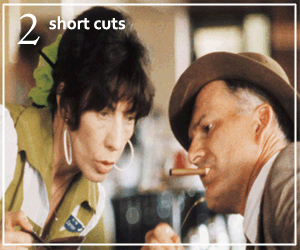 2. Short Cuts (Altman, 1993)
2. Short Cuts (Altman, 1993)
Suburbia as a central theme of art sort of deserves a list of its own. The creation of a middle class, and the responding ennui to said class’s haven, the suburbs, has through the late 1900s inspired many artists to confront the boredom and lazy conformism that allegedly is littered all over those mass-produced, soulless neighbourhoods. Surburbia has in itself become a cliché. However, while many artists have fed on an anger over the mere mediocrity of that tasteless and genderless bourgeoisie who inhabit it, a lot of provoking and, maybe more importantly, psychologically recognisable pieces of art have sprung from this wellspring of inspiration, this collection of half-cities. The marriage of American novelist Raymond Carver and the rebel auteur Robert Altman was long underway, but it was — and remains — a match made in heaven, as it unfolds in Short Cuts. Though both the novelist and the director are dead and gone, their respective writing and filmmaking brings with it a sharpness, eternally fresh; also, a cynical joy, as well as a humanistic desire not to explain, but to display the interactions of people. In Altman’s world, it seems that whether we want to or not, we do live next to each other and can’t avoid it, so we might as well try to make the best of it. In Carver’s universe, the prosaic conclusion is that as we are alienated from each other, we might abuse and dislike our neighbour. Even in that, however, we may find solace or comfort — conformism indeed, however strange. America as Camus could have described it. With a merciless irony rooted in the very title of the film (it is not short at all!), Altman weaves one brilliant portrayal after the other into a tapestry of bitterness and sad reciprocity. The result is instantly entertaining, shockingly familiar and hilariously phlegmatic. And while one has to argue with oneself how to approach at all such a masterfully acted, edited, directed and written presentation of surburbia — miraculously both spectacular and mundane at the same time — Short Cuts does take its place as not only one of Altman’s finest offerings, but literally one of the more stunning films of the 1990s. Suburbia? Only if you dare. -T. Frovin, Denmark |
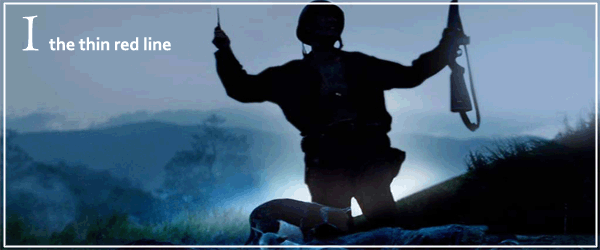 1. The Thin Red Line (Malick, 1998) 1. The Thin Red Line (Malick, 1998)
A few months after the release of Terrence Malick's most recent film, The New World, critic J. Hoberman of Village Voice drafted an article noting that the film was reaching "cult" status. The connotation of the types of films that term is usually reserved for aside, Malick's oeuvre has inspired a certain amount of fervor amongst many cineastes. True to this, the only film he released in the '90s (and at the time, his first film in two decades) has resoundingly come on top of our poll. It may be hard to pinpoint precisely why Malick, and The Thin Red Line specifically, still incites a distinct level of passionate response, especially in an era when realism has questioned provocation and style (fittingly, the likes of Kiarostami, Hou, the Dardenne brothers and Tsai are peppered throughout our list). Simply put, today poetry seems to mean less than the cold, hard facts in many circles — critic Jonathan Rosenbaum said of The New World that he was "hoping for something a little more grown-up and educational.” The clash of realism versus poetry transpired in 1998, when The Thin Red Line was released in the same calendar year with Steven Spielberg's Saving Private Ryan. Despite being two very different films, the fact that both were set in World War II and were competing for Best Picture at the Academy Awards meant a comparison was drawn. Spielberg's film, a critical and commercial success (that did not make our list, it should be noted), took what was considered a more "realistic" approach in its intent, next to Malick's pondering, philosophical and at times dreamlike film that incited passion amongst many critics, but was labeled a box office failure. Although certainly unrealistic and manipulative in its own right, Saving Private Ryan was considered the more direct depiction of war: a visceral, violent experience meant to convey the horror of being shot at and witnessing those around you dying in gruesome ways. Malick's film, by contrast, is a poetic and at times confusing rumination on a host of topics that aren’t necessarily exclusive to war: collective consciousness, coming to terms with the existence (and perhaps even necessity) of violence that occurs in the natural world, the struggles of natural and human order, and so on. The beauty of The Thin Red Line — much like the expressionist films of F.W. Murnau which were a partial influence for Malick — is that despite being so "unrealistic," it manages to strike true to some very real conundrums in the human condition and natural order. The truths it conveys are ultimately more relevant to the human experience than the horror of bullets aimed in our direction, something most viewers will thankfully never experience outside of the theater. Other films are about war — Malick’s film is bigger than that: war is simply an example used to foster discussion of greater themes. It's a layered, dense work that upon further viewings and contemplation always reveals more insights and more questions, and becomes even more bottomless in its possibility for analysis. And more immediately, it's a beautiful, sorrowful film that is both moving and inspiring. Instead of offering a direct recreation of events permeated by a specific cinematic school of thought, The Thin Red Line provides an experience of textured cinematography, unique editing rhythms, distinctive narration, an intentionally confusing, shifting focus on its ensemble cast and depiction of events, and a thoughtfulness that separates the film from any contemporary trends or movements. Effectively, Terrence Malick has developed his own brand of expressionism. And The Thin Red Line stands as not only his most notable work to date, but as the finest film of the decade in which it was released. |
| © 2010 INTERNATIONAL CINEPHILE SOCIETY. ALL RIGHTS RESERVED. | ICS - 100 - 90 - 80 - 70 - 60 - 50 - 40 - 30 - 20 - 10 |